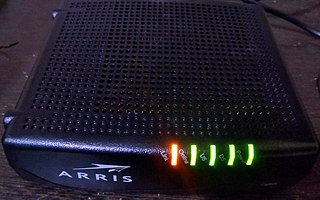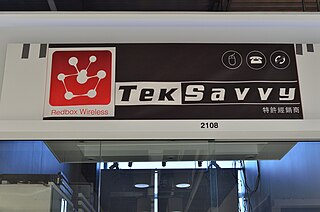
A cable modem is a type of network bridge that provides bi-directional data communication via radio frequency channels on a hybrid fibre-coaxial (HFC), radio frequency over glass (RFoG) and coaxial cable infrastructure. Cable modems are primarily used to deliver broadband Internet access in the form of cable Internet, taking advantage of the high bandwidth of a HFC and RFoG network. They are commonly deployed in the Americas, Asia, Australia, and Europe.

In telecommunications, broadband or high speed is the wide-bandwidth data transmission that exploits signals at a wide spread of frequencies or several different simultaneous frequencies, and is used in fast Internet access. The transmission medium can be coaxial cable, optical fiber, wireless Internet (radio), twisted pair cable, or satellite.
Data Over Cable Service Interface Specification (DOCSIS) is an international telecommunications standard that permits the addition of high-bandwidth data transfer to an existing cable television (CATV) system. It is used by many cable television operators to provide cable Internet access over their existing hybrid fiber-coaxial (HFC) infrastructure.
Vidéotron is a Canadian integrated telecommunications company active in cable television, interactive multimedia development, video on demand, cable telephony, wireless communication and Internet access services. Owned by Quebecor, it primarily serves Quebec and Ottawa, as well as the Francophone communities of New Brunswick and some parts of Eastern Ontario. Its principal competitors are Bell Canada and Telus Communications.
Cox Communications, Inc. is an American digital cable television provider, telecommunications and home automation services. It is the third-largest cable television provider in the United States, serving approximately 6.5 million customers, including 2.9 million digital cable subscribers, 3.5 million Internet subscribers, and almost 3.2 million digital telephone subscribers, making it the seventh-largest telephone carrier in the country. Cox is headquartered at 6205 Peachtree Dunwoody Rd in Sandy Springs, Georgia, U.S., in the Atlanta metropolitan area. It is a privately owned subsidiary of Cox Enterprises.
Bandwidth throttling consists in the limitation of the communication speed, of the ingoing (received) or outgoing (sent) data in a network node or in a network device such as computers and mobile phones.

TelstraClear Limited was New Zealand's second-largest telecommunications company before being acquired by Vodafone New Zealand in October 2012, previous to which it was a subsidiary of Australian company Telstra.

Comcast Cable Communications, LLC, doing business as Xfinity, is an American telecommunications business segment and division of Comcast Corporation. It is used to market consumer cable television, internet, telephone, and wireless services provided by the company. The brand was first introduced in 2010; prior to that, these services were marketed primarily under the Comcast name.
Spectrum is the trade name of Charter Communications, which is widely used by market consumers and commercial cable television channels, internet, telephone, and wireless service providers.

Virgin Media is a telecommunications company from England, founded in 2007, which provides telephone, television and internet services in the United Kingdom. Its headquarters are at Green Park in Reading, England. It is owned by Virgin Media O2, a 50:50 joint venture between Liberty Global and Telefónica.
In telecommunications, cable Internet access, shortened to cable Internet, is a form of broadband internet access which uses the same infrastructure as cable television. Like digital subscriber line and fiber to the premises services, cable Internet access provides network edge connectivity from the Internet service provider to an end user. It is integrated into the cable television infrastructure analogously to DSL which uses the existing telephone network. Cable TV networks and telecommunications networks are the two predominant forms of residential Internet access. Recently, both have seen increased competition from fiber deployments, wireless, mobile networks and satellite internet access.
Internet access is widely available in New Zealand, with 94% of New Zealanders having access to the internet as of January 2021. It first became accessible to university students in the country in 1989. As of June 2018, there are 1,867,000 broadband connections, of which 1,524,000 are residential and 361,000 are business or government.

Canada ranks as the 21st in the world for Internet usage with 31.77 million users as of July 2016 (est), making up 89.8% of the population. According to Harvard researchers, Canada has some of the lowest internet standards among OECD countries, as a result of high costs and slow internet speeds.
Novus Entertainment is a Canadian telecommunications company providing television, digital phone, and high-speed Internet services via a fiber-optic network. The company is licensed by the Canadian Radio-Television and Telecommunications Commission as a Class 1 Broadcast Distribution Undertaking for both Metro Vancouver. Novus presently provides services to apartments, condominiums, and businesses in Metro Vancouver. Novus is one of the few broadband Internet carriers in Canada to offer a Fibre-to-the-Building (FTTB) network. The company continues to expand its service in Metro Vancouver.
Hart v. Comcast was a suit filed by Jon Hart, a citizen of California against Comcast in Alameda County. Comcast is a provider of internet access and services. The suit alleged that Comcast was illegally interfering with certain types of internet traffic, such as BitTorrent. The suit alleged that Comcast is guilty of false advertising for advertising high speed services yet deliberately using technology to interfere with access speeds. The suit also claimed Comcast's actions violated established Federal Communications Commission policies on Net Neutrality. The case has since been settled out of court.
Smallworld Fibre was a British telecommunications company based in Irvine, North Ayrshire. Their coverage area used to be Irvine, Dreghorn, Troon, and Kilmarnock in the west of Scotland, and Carlisle, Lancaster and Morecambe in the northwest of England, where they served over 40,000 homes. Smallworld provided broadband, telephone, and digital television services to residential customers from 2001 to 2014, when the company was acquired by Virgin Media.

UPC was the largest cable operator in Switzerland with around 1.1 million residential and business customers and was formed in 1994 through the merger of several cable operators. UPC has been a subsidiary of Liberty Global from 2005 until its discontinuation in 2022.
Net neutrality in Canada is a debated issue, but not to the degree of partisanship in other nations, such as the United States, in part because of its federal regulatory structure and pre-existing supportive laws that were enacted decades before the debate arose. In Canada, Internet service providers (ISPs) generally provide Internet service in a neutral manner. Some notable incidents otherwise have included Bell Canada's throttling of certain protocols and Telus's censorship of a specific website critical of the company.

TekSavvy Solutions Inc. (TSI) is a Canadian residential, business, and wholesale telecommunications company based in Chatham, Ontario. In most of the country, it is a wholesale-network-access-based service provider and voice reseller, connecting its service to existing last mile networks from telecom carriers Bell Canada and Telus Communications, and cable carriers Rogers Communications, Cogeco Cable, Shaw and Vidéotron. However, in parts of rural southwestern Ontario, the service is provided over TekSavvy's own fixed wireless network. Recently they have also rolled out their own fibre optic network in parts of southwestern Ontario.
Net bias is the counter-principle to net neutrality, which indicates differentiation or discrimination of price and the quality of content or applications on the Internet by ISPs. Similar terms include data discrimination, digital redlining, and network management.








